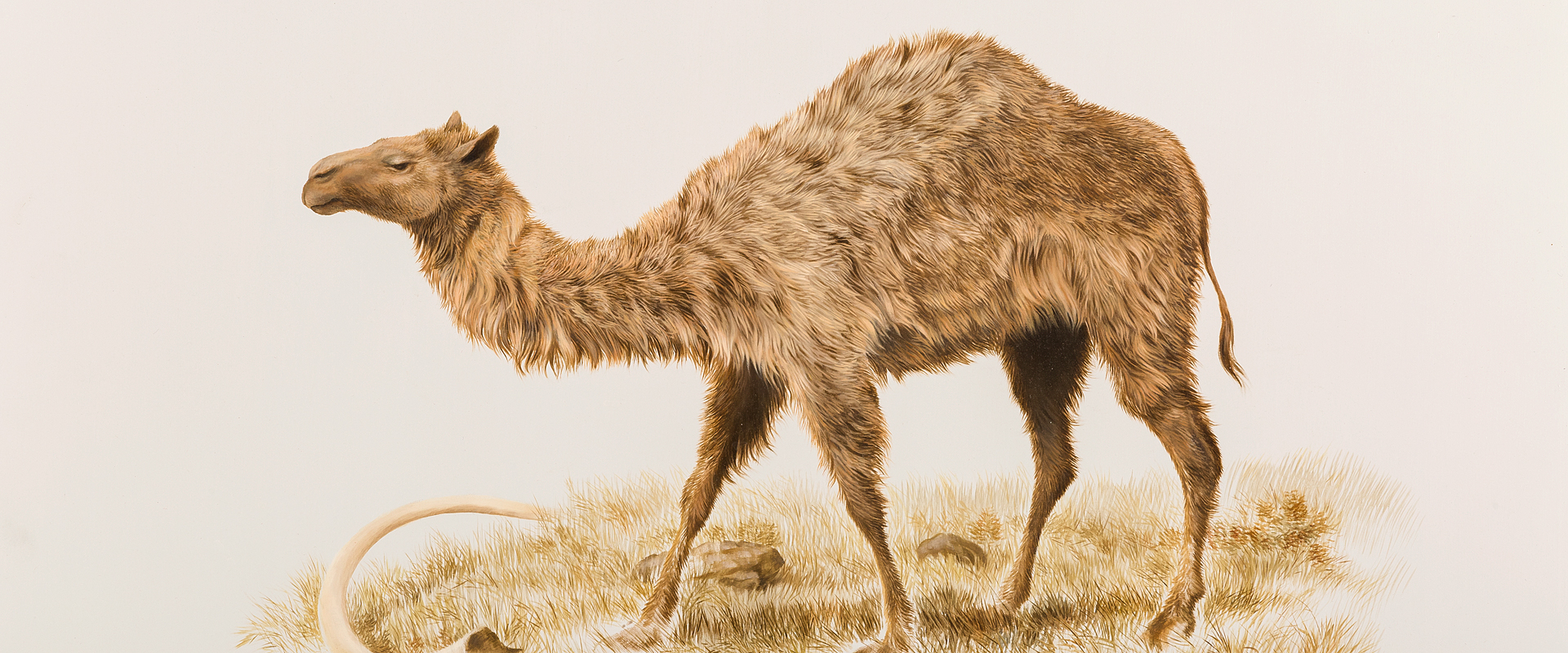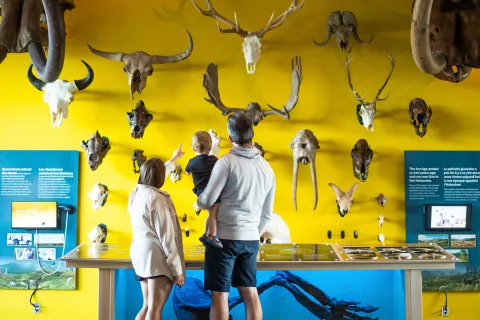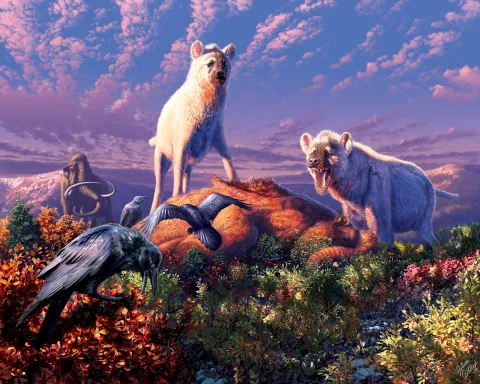- Log in to post comments
The thought of camels generally conjures up images of Lawrence of Arabia and vast sand seas in the deserts of the Middle East, Africa, and central Asia. As with most natural history, pictures created by Hollywood or cable TV are missing a big piece of the story. Few people think of the Arctic of the Ice Age when camels come to mind. However, a growing body of fossil evidence buried in the frozen ground of northern Canada clearly shows that the Arctic holds answers to how the camel family came to inhabit the Earth's deserts.
![]()
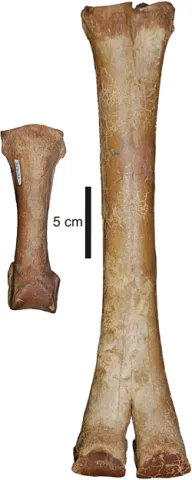
fossil foot (right) and toe (left) bones
found at Hunker Creek, Yukon in 2008.
Preserved DNA extracted from fossils found in Yukon, Canada has enabled Dr. Peter Heintzman of the University of California, Santa Cruz to reconstruct the family tree for the last known camel species to live in North America—the ice age western camel, Camelops hesternus. These results and new family tree are reported in the Journal Molecular Biology and Evolution.
During the ice age, when vast glaciers covered much of Canada, megafaunal species like woolly mammoth and steppe bison adapted to the cold, harsh climates by taking refuge in the unglaciated regions of Alaska and northwest Canada. In areas to the south of the ice caps, ice age climates were not as extreme, permitting a great diversity of mammals and other animals, including the western camel.
The western camel was a large-bodied member of the camel family that probably looked a lot like the living dromedary camel, with a long, powerful neck and a single hump on its back. However, the fossil camel's legs were probably around one fifth longer. Western camels had a long, narrow head, and the shape of its mouth and teeth suggest it may have eaten a variety of plants, grasses, twigs and leaves.
Western camels were one of roughly 70 mammal species that went extinct in North America around 13,000 years ago. This was a time when the Earth was coming out of the last Ice Age, and climates were warming, glaciers melting, and environments rapidly changing. It was also near the time when the first humans crossed the Bering Land Bridge from Asia and spread across North America. We know that these first peoples hunted western camels for meat, because butchered camel bones are found at a few early North American archeological sites.
Although hundreds of fossil sites with thousands of western camel fossils have been found in the warmer parts of western North America, such as California, Nevada, and Arizona, only a small handful of ice age camel bones have been found in Alaska and Yukon. As such, it came as a surprise to Dr. Ross MacPhee of the American Museum of Natural History when he picked a couple of odd-looking bones from a pile of typical ice age mammal fossils at a gold mine on Hunter Creek, just outside of Dawson City, Yukon during field work in 2008. These bones turned out to be those of a rare western camel.
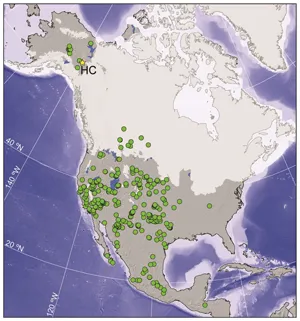
camel during the Pleistocene with
continental ice sheets over North America.
HC refers to "Hunker Creek" in Yukon.
Like all good scientific tales, however, sometimes things are more complicated than they appear. Dr. Grant Zazula of the Yukon Government Palaeontology Program was a bit skeptical of where palaeontologists had previously placed the ice age western camel on the family tree. To more closely investigate the history of these extinct camels. he sent small pieces from three of these bones to Dr. Heintzman, who is a postdoctoral scholar in the UCSC Paleogenomics lab headed by Dr. Beth Shapiro. Her group specializes in extracting and analyzing DNA preserved in fossils to examine their evolution and adaptations during the Ice Age.
The camel family originated in North America around 40 million years ago. Since then, dozens of species evolved and two main branches on the family tree eventually formed. One of those branches led to dromidary and Bactrian camels we all know well from today's desert regions. The other branch led to the llamas and alpacas nowadays restricted to South America. Most extinct members of this family tree can be placed on one or the other branch based on the shape and size of fossil bones, skulls and teeth. For the last hundred years or so, palaeontologists have placed the ice age western camel on a dead-end part of the branch that includes llamas and alpacas.
"The genomic results completely contradicted the traditional palaeontological story. Instead of being closely related to llamas and alpacas, as has been considered for decades, the ice age western camels are actually much more closely akin to living dromedary and Bactrian camels. These Yukon fossils radically rearrange our understanding of the camel family tree," says Dr. Heintzman.
"Dr. Shapiro and Dr. Heintzman are world experts in the study of permafrost preserved ancient DNA from fossils. It is a real pleasure to reach out to such leading scientists to help us study the amazing record of ice age fossils that are found from the gold mines in the Yukon," says Dr. Grant Zazula.
The new results based on ancient DNA from these Yukon fossils indicate that ice age western camels split off from the branch that includes modern-day camels around 10 million years ago. While the direct ancestors of modern camels inhabited the arctic and spread across the Bering Land Bridge into Asia around 7 million years ago, the western camel branch stayed in North America until the end of the Ice Age.
For most of their history, western camels stayed home in the southern part of North America. Fossils from Alaska and Yukon tell scientists that western camels made their way north during a relatively warm part of the last ice age around 100,000 years ago. When they arrived in the arctic, however, the Bering Land Bridge was flooded and kept them from migrating to Asia like their cousins did. They also do not seem to have arrived in the north in large numbers, or to have lived there very long, because they are very rare in the fossil record of Alaska and Yukon.
"Bones and teeth of woolly mammoth, bison, horse, and caribou are the things normally found at goldmine sites in the Yukon. Camels are not!" says Dr. MacPhee, who has been conducting research across the Arctic to try to figure out why so many mammals went extinct at the end of the Ice Age.
Dr. Grant Zazula says, "We are continuing our research on ice age camels using radiocarbon dating and other types of analyses to figure out when they lived in Alaska and Yukon, what they ate, and why they disappeared."
Resolving whom is related to who on the tree of life is a key part of evolutionary biology and paleontology. Strangely enough, camel fossils from Canada's frozen north have helped to make a major step forward into understanding the history of a mammal group best known from deserts around the world.
Contacts and affiliations:
Peter Heintzman, University of Calafornia Santa Cruz: peteheintzman@gmail.com
Grant Zazula, Government of Yukon: grant.zazula@gov.yk.ca
Ross MacPhee, American Museum of Natural History: macphee@amnh.org
Reference: Genomic data from extinct North American Camelops revise camel evolutionary history. Peter D. Heintzman, Zazula GD, Cahill JA, Reyes AV, MacPhee RDE, Shapiro BS. 2015. Molecular Biology and Evolution. Oxford University Press.
